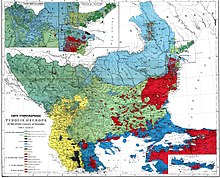Dobrujan Arabs
العرب الدبروجية al-‘Arab ad-Dubrūjīyah | |
|---|---|
 Dobrujan Arab men, between 19th and 20th century | |
| Languages | |
| Arabic,* Dobrujan Tatar, Turkish | |
| Religion | |
| Islam | |
| Related ethnic groups | |
| Arabic people | |
Arabic is probably not well-known due to assimilation. The number of people is unknown. |

Dobrujan Arabs (Arabic: العرب الدبروجية, romanized: al-‘Arab ad-Dubrūjīyah) are Arab people who assimilated into Tatar-Turkish population in Dobruja.[1] They were brought from Syria to Dobruja in the 19th century.
History
[edit]

There were Arabs brought from Syria to Dobruja by the Ottomans in the 19th century. At first the Ottomans brought them to Istanbul, where they worked in carpet factories. When the factories closed, they were jobless, and due to Ottoman policy (according to the law, it was not possible to stay in Istanbul without working) they were brought to Dobruja by the Ottomans in 1843.[2] The population was 255 people.[3] In Dobruja they worked as farmers. According to Ottoman sources, these people were housed in some towns in Dobruja, with generous state support.[4]
The Arabs were highly valued for their skill in practicing agriculture in drought conditions.[5] The territory on which they settled is crossed today by the Romanian-Bulgarian border. Of the five settlements, the most important was Dokuz Ağaç ("Nine trees"), today Măgura, a village in Cerchezu Commune, Constanța County, Romania. They were the only Arab settlements in Europe. The Ottoman census of 1856 reports 145 Arabs (0.9%) in Dobrogea,[6] but their number increased significantly after this date. In 1861, French geographer Guillaume Lejean mentioned the fact that during his trip through the Balkan Peninsula in 1854, one of these settlements, Arap-Köy, was already abandoned, while the rest of the settlements enjoyed some prosperity. In 1878, Dobrogea was divided between Romania and Bulgaria, and the new border crossed the area inhabited by Arabs. After this date, the Arab settlements begin to decline, and part of the population emigrates to the Ottoman Empire.[7]
A few decades later, in 1913, the Swiss anthropologist Eugène Pittard mentions that these colonies have dissolved and manages to find only a remnant of 14 unassimilated Arabs in the area, all men. Following anthropological analyses, Pittard concluded that some of them had Negroid racial influences and relates this situation to the fact that the Arab population around the Red Sea often shows Negroid racial influences, as a consequence of the African slave trade practiced there in the past and their assimilation by the majority Arab population. Pittard concludes that it is very possible that some of the Dobrujan Arabs have ancestors originating from this area.[8]
In I World War, while planning a attack to the Suez Canal were noticed by the Ottomans that "there were two other volunteer groups made up of Turks, Syrian Arabs, Albanians and others from Romania".[9]
List of villages
[edit]| Ottoman Turkish name[10] | Current name | Arab families in 1843[10] |
|---|---|---|
| İlbey | 27 | |
| Musa Bey | 34 | |
| Kara İlyas | 2 | |
| Dokuz Ağaç | 31 | |
| Poyraz | 39 | |
| Aydın Bey | 14 | |
| Oğuzlar | 19 | |
| Çalmarça | 39 | |
| Bayram Dede | 50 |
Citations
[edit]- ^ Grigore 1999.
- ^ Mohammed Binzouba 2024, pp. 235–238.
- ^ Mohammed Binzouba 2024, pp. 239.
- ^ Mohammed Binzouba 2024, pp. 249–254.
- ^ M. D. Ionescu, Dobrogea in pragul veacului al XX-lea, Bucharest, 1904
- ^ Dobruja, 1856
- ^ Lejean 1861.
- ^ Pittard 1913.
- ^ Mohammed Binzouba 2024, pp. 234.
- ^ a b Mohammed Binzouba 2024, p. 242.
Sources
[edit]- Mohammed Binzouba, Majed (2024). "19. Yüzyıl Osmanlı Coğrafyasında Bir İskân Örneği: Dobruca'da Arap Köyleri". Osmanlı Araştırmaları/ The Journal of Ottoman Studies (in Turkish and English).
- Grigore, George (1999). "George Grigore. "Muslims in Romania", ISIM Newsletter (International Institute for the Study of Islam in the Modern World) no. 3, Leiden. 1999: 34".
- Lejean, Guillaume (1861). Ethnographie de la Turquie d'Europe. Petermanns Geographischen Mitteilungen.
- Pittard, Eugène (1913). Contribuition à l'étude anthropologique des arabes. Le Globe.
